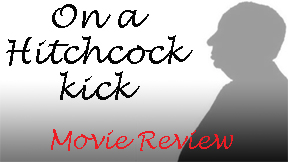“Vertigo” (1958) is the second-best film of all time according to Sight & Sound’s 2022 worldwide poll of critics and directors, beaten out only by 1975’s “Jeanne Dielman, 23, quai du Commerce, 1080 Bruxelles.” It’s the 103rd best film of all time according to the general public in the IMDb rankings, behind three other Alfred Hitchcock films.
It might surprise some people that the No. 2 film of all time has flaws and doesn’t follow a standard narrative structure. But if it was perfect, that might make it boring – and “Vertigo” is certainly not that. The film is mesmerizing thanks to Bernard Herrmann’s gorgeous score, the vibrant visuals of San Francisco, James Stewart’s performance as a man losing his tether to reality, and Kim Novak’s turn as an ethereal woman who has no characterization yet is the story’s centerpiece.
In a parallel to its lack of boringness, it’s not crystal-clear what is happening or what thematic points Hitchcock is imparting. A film like this isn’t going to climb as high in the general-public ratings as it does with critics. That having been said, “Vertigo” is not a pretentious arthouse work. The opposite is the case: It has a magnetic, hypnotic draw that encourages rewatches and rethinking. It does for suspense-mysteries what “Blade Runner” (1982) would do for sci-fi.

“Vertigo” (1958)
Director: Alfred Hitchcock
Writers: Alec Coppel, Samuel A. Taylor (screenplay); Pierre Boileau, Thomas Narcejac (novel)
Stars: James Stewart, Kim Novak, Barbara Bel Geddes
“Vertigo” is an unusually long (by old-movie standards) 2 hours and 8 minutes, and it feels complete two-thirds of the way through when the core narrative is capped by a tragic death. Then Stewart’s Scottie meets a whole ’nother woman (or so it seems) and that relationship carries us to the actual end (but not the end of our thoughts about what we’ve seen).
(SPOILERS FOLLOW.)
The ‘Sixth Sense’ effect
The list of possible readings of “Vertigo” expanded further in 1999 with the release of “The Sixth Sense.” That wasn’t the first film where a deceased character is presented as being alive via cinematic trickery, but M. Night Shyamalan does directly utilize the old-school transition from thrilling opening sequence to calm aftermath in order to fool us. We see Bruce Willis’ character seriously wounded, but when he’s fine in the next scene, we assume he recovered in the time between scenes.
“Vertigo” uses this transition. Scottie is hanging off a ledge, in mortal danger, then in the next scene he is safe and sound, lounging with his friend Midge (Barbara Bel Geddes) and discussing his acrophobia. If someone has “The Sixth Sense” on their mind, they can’t help but entertain the notion that Scottie died and is now a ghost (or there’s another supernatural explanation).

This feeling gets stronger when we follow Scottie on his supernaturally infused adventure. “Vertigo” is a rare non-horror film where the supernatural is heavily featured. As it turns out, Novak’s Madeleine/Judy was not possessed by the spirit of spurned 19th century wife Carlotta; she was acting for the sake of a grand scheme that would end with Scottie being a corroborator of the suicide of Elster’s wife. However, we don’t know that until we know it, so “Vertigo” feels like it’s about the supernatural.
A touch of the supernatural
And perhaps it actually is. In the last scene, a nun climbs the bell tower and accidentally startles the emotionally troubled Judy, who falls to her death. (Or, in an alternative reading, she leaps to her death out of guilt and fear.) But it’s open to interpretation: We (and Judy) might’ve seen a ghost, or a vision, rather than a human being.
Supporting the “Sixth Sense”-ian theory that the events of “Vertigo” don’t represent reality, it’s mostly from the POV of the troubled Scottie, similar to how Willis’ character is ever-present in the 1999 film. “Vertigo” shows a real-world narrative that Scottie is going through, but has stylish touches that make it grand art. In 1958, Scottie’s special-effects nightmare featuring a kaleidoscope of flowers – and the opening title sequence with disorienting spirals – perhaps impressed moviegoers.
Today, that stuff is old-fashioned and would have a corny quality if used in a new film, but “Vertigo’s” basic storytelling techniques also create a psychological imbalance – a mental vertigo. Scottie is obsessed with Madeleine/Judy, but not for any grounded reason. He’s simply smitten with her beauty.
In love with a woman, or with an object?
The objectification is clear upon their first meeting. Before Madeleine is aware of Scottie’s existence, he has saved her from a cold suicidal leap into the San Francisco Bay, dried her clothes and tucked her into his bed to warm her up. While Scottie likes Madeleine’s personality once they get to talking, it’s evident that he’s stuck on her beauty and sensuality. He says “I enjoyed … talking with you,” but that’s a bit of humor for us. We know he’s thinking “I enjoyed … just being in your presence.”
Later, though, Scottie becomes overt, firmly asking Judy to change her hair color to blonde. She’s willing to do so because she loves him. As with his love of her, this love isn’t backed up by anything substantial, making us wonder if Judy is a figment of Scottie’s imagination – too perfect to be real, but not so perfect that she’s boring. (One can see parallels between this romance and the one between Deckard and Rachael in “Blade Runner.” Both films’ romantic scenes emphasize the beauty of the actress, and the actors do project love, but there’s a fragility to it.)
It’s also noteworthy that Scottie is not 100 percent sure Madeleine and Judy are the same person until he sees they have the same necklace. Granted, Judy has insisted she is not the “dead” woman, and backs it up with evidence. And she has changed her hairstyle, eyebrow style, hair color, makeup and wardrobe.
And it’s possible Scottie is mildly face blind, so if someone tells him they are not the person he thinks they are, he has to consider that it might be true — that all beautiful women look similar to him and that he might be caught up on the Madeleine-Judy similarities due to his emotional issues.
But that’s just addressing Judy’s appearance. One would think that if two people really know and like each other, Scottie would realize Judy is his “Madeleine” after spending time with her. Since he does not – since he needs the necklace to solidify the continuity of character – that essentially confirms that “Vertigo” is a story of one man’s love of a woman for how she looks.
Don’t lose sleep over a remake
That Judy loves Scottie back despite his shallow nature (and keep in mind that Scottie is keeping the wonderfully real Midge at arm’s length this whole time) further enhances the “outside of reality” aspect of the film. By that, I mean a notch farther outside of reality even than cinema itself.
Through its flaws and successes — and through Scottie’s and Judy’s flaws, successfully portrayed by Stewart and Novak – “Vertigo” builds a compelling world that we want to revisit and maybe even live in: 1958 San Francisco without any of its annoyances; rather, a pretty place where we can play out a poignant romance and mesmerizing mystery.
A popular topic among film buffs is a fear that “Vertigo” will get remade someday, and the likelihood that things will be more robustly explained in the remake (except for maybe one intriguing unanswered question, thus preserving the artful quality). Unavoidably, a new filmmaker will want to tell us why Elster wants to kill his wife, why the proprietress tells Scottie that Madeleine didn’t enter the hotel, and so forth.
Hence, the magic will be lost in any new version, even if it is a masterpiece by the modern standards of how stories are told, and even if (in a reverse of the original) it goes over better with moviegoers than with critics. Maybe it would be in the vein of David Fincher’s “Se7en” (19th on the IMDb list, nowhere on the S&S list).
Thankfully, the bizarre (and even flawed) magic will always be preserved in Hitchcock’s “Vertigo.”
IMDb Top 250 trivia
- Despite ranking No. 2 in the Sight & Sound poll, “Vertigo” is No. 103 in IMDb’s Top 250 Movies with an 8.3 rating.
- IMDb voters prefer “The Shawshank Redemption” (No. 1, 9.3) and “The Godfather” (No. 2, 9.2).
- It’s the only 1958 film in the top 250.
RFMC’s Alfred Hitchcock series reviews works by the Master of Suspense, plus remakes and source material. Click here to visit our Hitchcock Zone.

